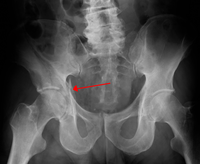
Photo from wikipedia
PURPOSE While frequently prescribed to patients following fixation for spine trauma, the utility of spinal orthoses during the post-operative period is poorly described in the literature. In this study, we… Click to show full abstract
PURPOSE While frequently prescribed to patients following fixation for spine trauma, the utility of spinal orthoses during the post-operative period is poorly described in the literature. In this study, we calculated rates of reoperation and performed a decision analysis to determine the utility of bracing following pedicle screw fixation for thoracic and lumbar burst fractures. METHODS Pubmed was searched for articles published between 2005 and 2015 for terms related to pedicle screw fixation of thoracolumbar fractures. Additionally, a database of neurosurgical patients operated on within the authors institution was also used in the analysis. Incidences of significant adverse events (wound revision for either dehiscence or infection or re-operation for non-union or instability due to hardware failure) were determined. Pooled means and variances of reported parameters were obtained using a random-effects, inverse variance meta-analytic model for observational data. Utilities for surgical outcome and complications were assigned using previously published values. RESULTS Of the 225 abstracts reviewed, 48 articles were included in the study, yielding a total of 1957 patients. After including patients from the institutional registry, together a total of 2081 patients were included in the final analysis, 1328 of whom were braced. Non-braced patients were older then braced patients, although this only approached significance (p=0.051). Braced patients had significantly lower rates of re-operation for non-union or clinically significant hardware failure (1.3% vs. 1.8%, p<0.001) although the groups had comparable rates of operative wound dehiscence and infection (p=1.000). These two approaches yielded comparable utility scores (p=0.120). Costs between braced and non-braced patients were comparable excluding the cost of the brace (p=0.256); hence, the added cost of the brace suggests that bracing post-operatively is not a cost effective measure. CONCLUSIONS Bracing following operative stabilization of thoracolumbar fracture does not significantly improve stability, nor does it increase wound complications. Moreover, our data suggests that post-operative bracing may not be a cost-effective measure.
Journal Title: Journal of Clinical Neuroscience
Year Published: 2017
Link to full text (if available)
Share on Social Media: Sign Up to like & get
recommendations!